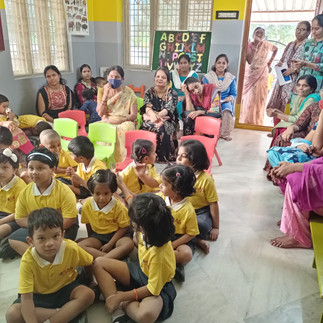Why You're Failing at Bone Health In Kids Session By Nutritionist
- Lee Health Domain
- Oct 31, 2022
- 3 min read
Physical activity, calcium, and vitamin D are essential for building strong bones, says Ms. Lavanya, Nutritionist & Dietician with the Lee Health Domain. Developing good bone health during childhood helps prevent fractures and osteoporosis later in life.

Typically, when parents think about their children’s health, they don’t think about their bones. But building healthy bones by adopting healthy nutritional and lifestyle habits in childhood is important to help prevent osteoporosis and fractures later in life.
Bone is living tissue in the skeleton that constantly changes. Old bone gets replaced with new. The greatest amount of bone tissue grows during childhood and adolescence as the skeleton expands in size and density. It is during this period of active growth when calcium is essential. In addition to requiring a great deal of calcium, the young body absorbs calcium more effectively. For this reason, children need to “bank” extra calcium for bone health.
Your children's bones will benefit from the same healthy practices that keep them going and developing. Being a good role model for your children is one of the finest methods to develop healthy behaviors in them. Your children are watching, believe it or not, and your behaviors, both good and bad, have a tremendous impact on theirs.
Proper diet and plenty of physical activity are the two most critical lifetime bone health behaviors to encourage right now. Milk, yogurt, and cheese are examples of typical dairy items that are also good sources of calcium. Unfortunately, the fat found in dairy products prevents the body from absorbing calcium. Therefore, fat-free dairy products should be a source of calcium for kids and should be consumed at least an hour before meals. Soy milk and juices, canned salmon (with bones) and sardines, and dark green leafy vegetables like broccoli and kale are other good sources of calcium.
Ms Lavany shared key points parents should keep in mind:
1. Get your children moving
At least five times each week. Children as young as three years old should be active for at least 60 minutes per day, while children and teens in grades six through twelve should be active for at least three hours each day (ages 6 through 17 years).
2. Provide a calcium-rich diet to your children
Low to moderate calcium levels can be found in dairy products. Southerners can get their fill of calcium from consuming ragi. Approximately 350–375 milligrams of calcium may be found in every 100 grams of ragi. Ragi should be a staple in everyone's diet. North Indians can use Rajma or Sesame for Ragi if they can't get it. Rajma has between 275 and 300 milligrams of calcium, whereas sesame contains 800 milligrams. This makes it a form of calcium that is both highly concentrated and readily accessible.
3. Avoid colas, sodas, and aerated drinks in your child's diet.
Excessive use of carbonated beverages, especially among youngsters, has been linked to decreased bone mass. Consumers of cola beverages are at a greater risk of not getting enough of the essential nutrients calcium and vitamin D because they are less likely to consume milk and calcium-fortified juice.
4. Keep an eye on your child's posture while they're watching TV or taking online lessons.
Children should always be seated in accordance with the 90-90-90 guidelines. The ideal sitting position for your child is one in which his elbows, hips, and knees form right angles of 90 degrees to one another. Your child's desk should be at the same level as his or her elbow. Adjusting the height of the chair may be necessary to ensure that a little kid is seated properly. If your kid sits with his or her feet hanging off the edge of the couch or the table, you should get him or her a footrest or a stool.
Disclaimer: This content including advice provides generic information only. It is in no way a substitute for a qualified medical opinion. Always consult a specialist or your own doctor for more information. Lee Health Domain does not claim responsibility for this information.







Comments